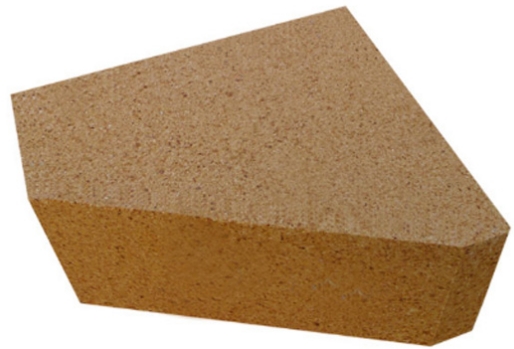- 01
- Oct
Savi kaari tiili
Savi kaari tiili

1. The arch-foot clay bricks are made of 50% soft clay and 50% hard clay clinker, mixed according to a certain particle size requirement, and after molding and drying, they are fired at a high temperature of 1300 to 1400 ℃. Clay refractory bricks are weakly acidic refractory products, which can resist the erosion of acid slag and acid gas, and have a slightly weaker resistance to alkaline substances. Clay bricks have good thermal properties and are resistant to rapid cold and rapid heat.
Yrityksemme valmistamat tulenkestävät savitiilit perustuvat tavallisten savitiilien tuotantoon, ja pääraaka-aineena käytetään korkealaatuisia homogenisoivia materiaaleja, lisätään sopivat määrät apumateriaaleja ja joitain lisäaineita hienojakoisen, sekoittamisen ja korkeapaineen jälkeen muovaus ja sitten asianmukainen polttaminen Se muuttuu mulliittikidefaasiksi lämpötilassa, ja jäännöstuotteella on hyvä mineraalikoostumus, jotta voidaan varmistaa, että savi tulenkestävä tiili on erittäin tulenkestävä, tiheä irtotiheys, alhainen huokoisuus, erinomainen korkean lämpötilan ryömintä ja hyvä äänenvoimakkuuden vakaus.
1. Refractoriness: The refractoriness of general clay bricks is 1580~1730℃.
2. Kuorman pehmenemislämpötila: Koska savitiileillä on nestefaasi alemmassa lämpötilassa ja ne alkavat pehmentyä, ne muuttuvat, jos ne altistuvat ulkoisille voimille, joten savitiilien kuormituksen pehmenemislämpötila on paljon alhaisempi kuin tulenkestävyys, vain noin 1350 ℃.
3. Kuonankestävyys: Savitiilit ovat heikosti happamia tulenkestäviä materiaaleja. Ne kestävät hapon kuonan eroosiota, mutta niiden vastustuskyky emäksiselle kuonalle on hieman heikompi.
4. Thermal stability: The thermal expansion coefficient of clay brick is small, so its thermal stability is good. The number of water cooling at 850°C is generally 10 to 15 times.
5. Volume stability: Clay bricks will recrystallize at high temperatures, which reduces the volume of the bricks. At the same time, a liquid phase is produced. Due to the surface tension of the liquid phase, the solid particles are close to each other, the porosity is low, and the volume of the brick is reduced. Therefore, the clay brick has the property of residual shrinkage at high temperature. ,
2. Savikaaritiilien päätarkoitus:
1. Savitiilejä käytetään pääasiassa savitiilien rakentamiseen, masuuneihin, kuumauuneihin, rautauuniin, avouuneihin ja sähköuuneihin, joissa savitiilejä käytetään alemmissa lämpötiloissa. Savitiilejä käytetään teräsrumpuihin, tiileitä valujärjestelmiin, lämmitysuuneihin, lämpökäsittelyuuniin, polttokammioihin, hormiin, savupiippuihin jne.
2. Savitiilit ovat heikosti happamia tulenkestäviä tuotteita, jotka kestävät happaman kuonan ja happaman kaasun eroosiota ja joiden vastustuskyky emäksisille aineille on hieman heikompi. Savitiilillä on hyvät lämpöominaisuudet ja ne kestävät nopeaa kylmää ja nopeaa kuumuutta.
3. The refractoriness of clay bricks is comparable to that of silica bricks, up to 1690~1730℃, but the softening temperature under load is more than 200℃ lower than that of silica bricks. Because the clay brick contains mullite crystals with high refractoriness, it also contains nearly half of the low melting point amorphous glass phase.
4. In the temperature range of 0~1000℃, the volume of clay bricks expands uniformly with the increase of temperature. The linear expansion curve is approximate to a straight line, and the linear expansion rate is 0.6%~0.7%, which is only about half of that of silica bricks. When the temperature reaches 1200 ℃ and then continue to increase, its volume will start to shrink from the expansion value. The residual shrinkage of the clay bricks leads to the loosening of the mortar joints of the masonry, which is a major disadvantage of the clay bricks. When the temperature exceeds 1200°C, the low melting point substances in the clay bricks gradually melt, and the particles are tightly pressed against each other due to surface tension, resulting in volume shrinkage.
5. Due to the low load softening temperature of clay bricks, it shrinks at high temperatures, and its thermal conductivity is 15%-20% lower than that of silica bricks, and its mechanical strength is also worse than that of silica bricks. Therefore, clay bricks can only be used for the secondary purpose of coke ovens. Parts such as the sealing wall of the regenerator, small flue lining bricks and checker bricks for the regenerator, furnace door lining bricks, furnace roof and riser lining bricks, etc.
3. Clay refractory products:
1. Tuotteet on jaettu fysikaalisten ja kemiallisten indikaattoreiden mukaan kolmeen luokkaan (NZ) -42, (NZ) -40 ja (NZ) -38.
2. The classification of the product conforms to the provisions of YB844-75 “Type and Definition of Refractory Products”. Generally divided into standard type, general type, special type, special type, and can also be specially made according to user requirements.
3. The shape and size of the product meet the requirements of GB2992-82 “General Refractory Brick Shape and Size”. If there is no brick type required by the buyer in the standard, it will be produced according to the buyer’s drawings.
4. T-38 clay brick size: 230*114*65/55
Application of arch-foot clay bricks: Mainly used in thermal boilers, glass kilns, cement kilns, fertilizer gas furnaces, blast furnaces, hot blast furnaces, coking furnaces, electric furnaces, bricks for casting and pouring steel, etc.
Fysikaaliset ja kemialliset indikaattorit:
| Sijoitus/Hakemisto | —级粘土砖 | 二级粘土砖 |
| N-1 | N-2 | |
| AL203 | 55 | 48 |
| Fe203% | 2.8 | 2.8 |
| Irtotiheys g / cm2 | 2.2 | 2.15 |
| Compressive strength with temperature MPa> | 50 | 40 |
| Kuormituksen pehmenemislämpötila ° C | 1420 | 1350 |
| Ajan suuruus ° C> | 1790 | 1690 |
| Näennäinen huokoisuus% | 26 | 26 |
| Lämmityksen pysyvä linjanvaihtoprosentti% | -0.3 | -0.4 |
